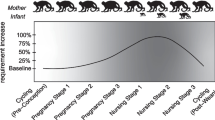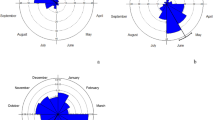Abstract
Although the energetics of the estrous cycle in primates is not well understood, evidence suggests that energy and nutrient acquisition influence ovulation and the timing of conception. Energy for estrus has to compete with energy allocated for cellular maintenance, thermoregulation, movement for food, and predation avoidance. While some chimpanzee (Pan troglodytes) populations do not have a seasonal birth period, evidence suggests that there is seasonality in the number of estrous females. Similarly, the onset of postpartum cycles has been reported to be seasonal. We used 33 months of data from the Taï National Park, Côte d’Ivoire, to examine how the number of estrous females in a given month was influenced by the abundance and distribution of food, diet, rainfall and temperature. In a second analysis, we examined if there was a seasonal effect on first estrous swellings in adolescent females and postpartum adult females. Results demonstrated that the number of females in estrous in a given month was positively related to food abundance and percent foraging time spent eating insects, and negatively related to mean rainfall in the two preceding months and the mean high temperature. The timing of first estrous swellings of postpartum females and prepartum young females was positively related to the food abundance, and negatively related to mean high temperature. These results showed that environmental conditions can seasonally limit the energetically demanding estrus cycle. The presence of estrous females increases gregariousness in chimpanzee communities, and this study identified environmental factors that affect estrus directly and hence social grouping indirectly.




Similar content being viewed by others
References
Altmann J (1974) Observational study of behavior: sampling methods. Behaviour 49:227–267
Altmann J (1980) Baboon mothers and infants. Harvard University Press, Cambridge
Anderson DP, Nordheim EV, Boesch C, Moermond TC (2002) Factors Influencing fission-fusion grouping in chimpanzees in the Taï Forest, Côte d’Ivoire. In: Boesch C, Hohmann G, Marchant LF (eds) Chimpanzee behavioural diversity. Cambridge University Press, Cambridge
Anderson DP, Nordheim EV, Bi ZBG, Boesch C (2005) Deviations in tropical tree phenology patterns caused by climatic variables. Biotropica (in press).
Bercovitch FB (1987) Female weight and reproductive condition in a population of olive baboons(Papio cynocephalus anubis). Am J Primatol 12:189–195
Boesch C, Boesch H (1983) Optimization of nut-cracking with natural hammers by wild chimpanzees. Behaviour 83:265–286
Boesch C, Boesch-Achermann H (2000) The chimpanzees of the Taï Forest: behavioural ecology and evolution. Oxford University Press, Oxford
Bronson FH (1989) Mammalian reproductive biology. University of Chicago Press, Chicago
Butynski TM (1988) Guenon birth seasons and correlates with rainfall and food. In: Gautier-Hion A, Bourlière F, Gautier JP Kingdon J (eds) A primate radiation: evolutionary biology of the African guenons. Cambridge University Press, Cambridge, pp 284–322
Chapman CA, Chapman LJ, Wrangham RW, Hunt K, Gebo D, Gardner L (1992) Estimators of fruit abundance of tropical trees. Biotropica 24:527–531
Chapman CA, Wrangham RW, Chapman LJ (1995) Ecological constraints on group size: an analysis of spider monkey and chimpanzee subgroups. Behav Ecol Sociobiol 36:59–70
Chapman CA, Wrangham RW, Chapman LJ, Kennard DK, Zanne AE (1999) Fruit and flower phenology at two sites in Kibale National Park, Uganda. J Trop Ecol 15:189–211
Coelho AM (1985) Baboon dimorphism: growth in weight, length and adiposity from birth to eight years of age. Monogr Primatol 6:125–129
Coley PD (1988) Effects of plant growth rate and leaf lifetime on the amount and type of anti-herbivore defense. Oecologia 74:531–536
Coley PD, Bryant JP, Chapin III FS (1985) Resource availability and plant antiherbivore defense. Science 230:895–899
Conklin-Brittain N, Wrangham R, Hunt K (1998) Dietary response of chimpanzees and cercopithecines to seasonal variation in fruit abundance. II. Macronutrients. Int J Primatol 19:971–998
Crockett CM, Rudran R (1987) Red howler monkey birth data I: Seasonal Variation. Am J Primatol 13:347–368
Deschner T, Meistermann M, Hodges K, Boesch C (2003) Timing and probability of ovulation in relation to sex skin swelling in wild West African chimpanzees, Pan troglodytes verus. Anim Behav 66:551–560
Doran D (1997) Influence of seasonality on activity patterns, feeding behavior, ranging, and grouping patterns in Tai chimpanzees. Int J Primatol 18:183–206
Fedigan LM, Rose LM (1995) Interbirth interval variation in three sympatric species of Neotropical monkey. Am J Primatol 37:9–24
Foley WJ, McArthur C (1994) The effects and costs of allelochemicals for mammalian herbivores: an ecological perspective. In: Chivers DJ, Langer P (eds) The digestive system in mammals: food, form and function. Cambridge University Press, Cambridge, pp 370–391
Freeland WJ, Janzen DH (1974) Strategies in herbivory by mammals: the role of plant secondary compounds. Am Nat 108:269–289
Goodall J (1986) The chimpanzees of Gombe: patterns of behavior. Belknap Press, Cambridge, Mass
Graham CE (1982) Ovulation time: a factor in ape fertility assessment. Am J Primatol 1[Suppl]:51–55
Koenig A, Borries C, Chalise MK, Winkler P (1997) Ecology, nutrition and the timing of reproductive events in an Asian primate, the hanuman langur (Presbytis entellus). J Zool 43:215–235
Lee PC, Bowman JE (1995) Influence of ecology and energetics on primate mothers and infants. In: Pryce CR, Martin RD, Skuse D (eds) Motherhood in human and non-human primates. Karger, Basel, pp 47–58
Lindburg DG (1987) Seasonality of reproduction in primates. In: Mitchell G, Erwin J (eds) Comparative primate biology, vol 2B: behavior, cognition, and motivation. Liss, New York, pp 167–218
Lindroth RL, Batzli GO, Avildsen SI (1986) Lespedeza phenolics and Penstemon alkaloids; effects on digestion efficiencies and growth of voles. J Chem Ecol 12:713–728
Martin P, Bateson P (1986) Measuring behavior: an introductory guide. Cambridge University Press, Cambridge
Matsumoto-Oda A, Oda R (1998) Changes in the activity budget of cycling female chimpanzees. Am J Primatol 46:157–166
Matsumoto-Oda A, Hosaka K, Huffman MA, Kawanaka K (1998) Factors affecting party size in chimpanzees of the Mahale Mountains. Int J Primatol 19:999–1011
Melnick DJ, Pearl MC (1987) Cercopithecines in multimale groups: genetic diversity and population structure. In: Smuts BB, Cheney DC, Seyfarth RM, Wrangham RW, Struhsaker TT (eds) Primate societies. University of Chicago Press, Chicago, pp 121–134
Murah KS, Sukumar R (1993) Leaf flushing phenology and herbivory in a tropical dry deciduous forest, southern India. Oecologia 94:114–119
Nadel ER (1983) Factors affecting the regulation of body temperature during exercise. J Therm Biol 8:165–169
Nadler RD, Graham CE, Gosselin RE, Collins DC (1985) Serum levels of gonadotropins and gonadal steroids, including testosterone, during the menstrual cycle of the chimpanzee (Pan troglodytes). Am J Primatol 9:273–284
Newton-Fisher N (1999) The diet of chimpanzees in the Budongo Forest Reserve, Uganda. Afr J Ecol 37:344–354
Nishida T (1990) The chimpanzees of the Mahale Mountains: sexual and life-history strategies. University of Tokyo Press, Tokyo
Patisaul HB, Whitten PL (1998) Dietary phytoestrogens. In: Naz RK (eds) Endocrine disruptors: effects on male and female reproductive systemss. CRC Press, Boca Raton, pp 89–123
Prentice AM, Paul AA, Prentice A, Black AE, Cole TJ, Whitehead RG (1986) Cross-cultural difference in lactational perfomance. In: Hamosh M, Goldman AS (eds) Human lactation 2: maternal and environmental factors. Plenum Press, New York, pp 13–44
Sokal RR, Oden NL (1978) Spatial autocorrelation in biology 1. Methodology. Biol J Linn Soc 10:199–228
Stanford C, Wallis J, Mpongo E, Goodall J (1994) Hunting decisions in wild chimpanzees. Behaviour 131:1–18
Strier KB (1991) Demography and conservation in an endangered primate, Brachyteles arachnoides. Conserv Biol 5:214–218
Strier KB, Ziegler TE (1994) Insights into ovarian function in wild muriqui monkeys (Brachyteles arachnoides). Am J Primatol 32:31–40
Strier KB, Ziegler TE (1997) Behavioral and endocrine characteristics of the reproductive cycle in wild muriqui monkeys, Brachyteles arachnoides. Am J Primatol 42:299–310
Strier KB, Mendes SL, Santos RR (2001) Timing of births in sympatric brown howler monkeys (Alouatta fusca clamitans) and northern muriquis (Brachyteles arachnoides hypoxanthus). Am J Primatol 55:87–100
Sun C, Kaplin BA, Kristensen KA, Munyaligoga V, Mvukiyumwami J, Kajondo KK, Moermond TC (1996) Tree phenology in a tropical montane forest in Rwanda. Biotropica 28:668–681
Takahashi H (2002) Female reproductive parameters and fruit availability: factors determining onset of estrus in Japanese macaques. Am J Primatol 57:141–153
Thompson GE (1977) Physiological effects of cold exposure. Int Rev Physiol 15:29–69
Tutin CEG, Fernandez M (1993) Relationships between minimum temperature and fruit production in some tropical forest trees in Gabon. J Trop Ecol 9:241–248
Wallis J (1992) Socioenvironmental effects on timing of first postpartum cycles in chimpanzees. In: Nishida T, McGrew WC, Marler P, Pickford M, deWaal F (eds) Topics in primatology, human origins. University of Tokyo Press, Tokyo, pp 119–130
Wallis J (1994) Socioenvironmental effects on first full anogenital swellings in adolescent female chimpanzees. In: Roeder JJ, Thierry B, Anderson JR, Herrenschmidt N (eds) Current primatology: social development, learning, and behavior. Université Louis Pasteur, Strasbourg, pp 25–32
Wallis J (1995) Seasonal influence on reproduction in chimpanzees of Gombe National Park. Int J Primatol 16:435–451
Wallis J (1997) A survey of reproductive parameters in the free-ranging chimpanzees of Gombe National Park. J Reprod Fert 109:297–307
Wallis J (2002) Seasonality of reproductive behaviour in chimpanzees at Budongo and Gombe. In: Boesch C, Hohmann G, Marchant LF (eds) Chimpanzee behavioural diversity. Cambridge University Press, Cambridge
Wallis J, Reynolds V (1999) Seasonal aspects of sociosexual behavior in two chimpanzee populations: A comparison of Gombe (Tanzania) and Budondo (Uganda). Am J Primatol 49:111(abstract)
Whitten PL, Naftolin F (1991) Dietary estrogens: a biologically active background for estrogen action. In: Hochberg R, Naftolin F (eds) The new biology of steroid hormones. Raven Press, New York, pp 155–167
Whitten PL, Lewis C, Russell E, Naftolin F (1995) Potential adverse effects of phytoestrogens. J Nutr 125[Suppl]:s771–776
Whitten PL, Kudo S, Okubo KK (1997) Isoflavonoids. In: D’Mello J (eds) Handbook of plant and fungal toxicants. CRC Press, Boca Raton, pp 117–137
Wrangham R, Conklin-Brittain N, Hunt K (1998) Dietary response of chimpanzees and cercopithecines to seasonal variation in fruit abundance. I. Antifeedants. I. Antifeedants. Int J Primatol 19:949–970
Young WC, Yerkes RM (1943) Factors influencing the reproductive cycle in the chimpanzee: the period of adolescent sterility and related problems. Endocrinology 3:121–154
Ziegler T, Hodges K, Winkler P, Heistermann M (2000) Hormonal correlates of reproductive seasonality in wild female hanuman langurs (Presbytis entellus). Am J Primatol 51:119–134
Acknowledgements
D.P.A. thanks Juichi Yamagiwa for the invitation to participate in the symposium African Great Apes: Evolution, Diversity and Conservation. Funding for this research was provided by the Max Planck Society, the L.S.B. Leakey Foundation, the National Science Foundation, and U.S.A.I.D. – Program for Science and Technology (Timothy Moermond, P.I.). We are grateful to the Ministries of Eaux et Forêts and La Recherche Scientifique for granting permission to conduct this study. The Projet Autonome pour la Conservation du Parc National de Taï, the Centre Suisse pour la Recherche Scientifique en Côte d’Ivoire, and the Centre de Recherche Ecologique were valuable collaborators in this research. We thank all of the assistants of the Taï Chimpanzee Project, especially those involved with the behavioral and vegetation data collection; Néné Kpazahi Honora, Kohou Nohon Grégoire, Glebeo Pierre Polé, Bally Wabo Albert, Tahou Mompeho Jonas, and Dji Troh Camille. Ronald Noë kindly provided the climate data. Susanne Anderson assisted with data collection and management. Thomas Gordon provided computer assistance in the field. Téré Henri helped with the identification of plant species. Jakob and Marie Zinsstag provided logistic support in Abidjan. Helpful comments on the manuscript were provided by Janette Wallis Thomas J. Givnish, Monica G. Turner, Timothy C. Moermond, Karen B. Strier, and two anonymous reviewers for their comments on this manuscript.
Author information
Authors and Affiliations
Corresponding author
About this article
Cite this article
Anderson, D.P., Nordheim, E.V. & Boesch, C. Environmental factors influencing the seasonality of estrus in chimpanzees. Primates 47, 43–50 (2006). https://doi.org/10.1007/s10329-005-0143-y
Received:
Accepted:
Published:
Issue Date:
DOI: https://doi.org/10.1007/s10329-005-0143-y




